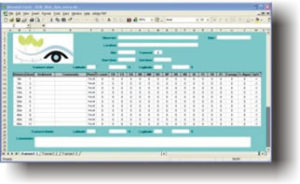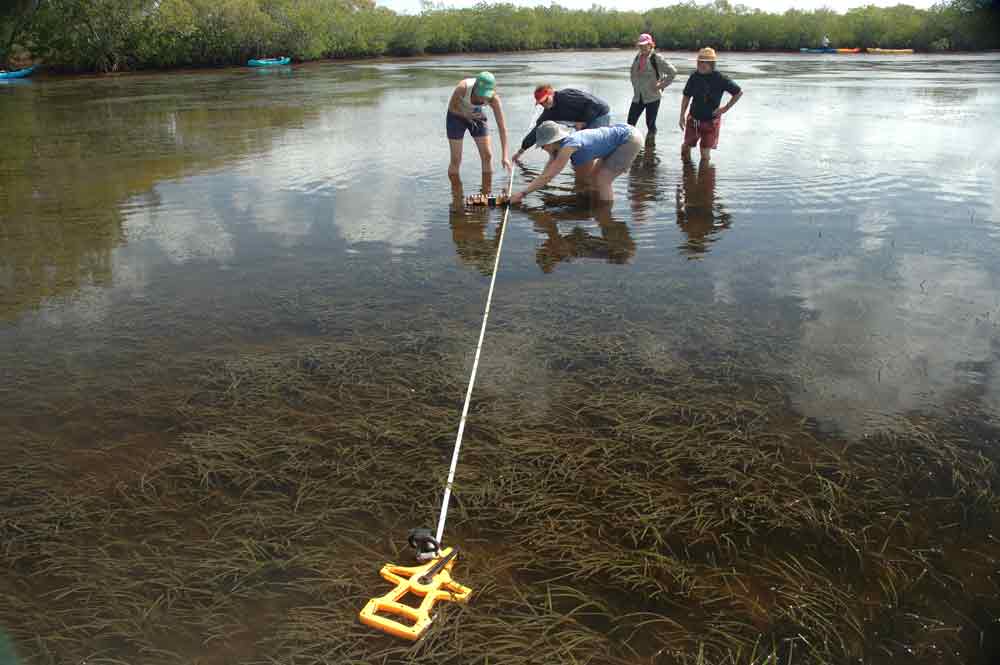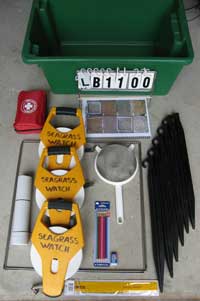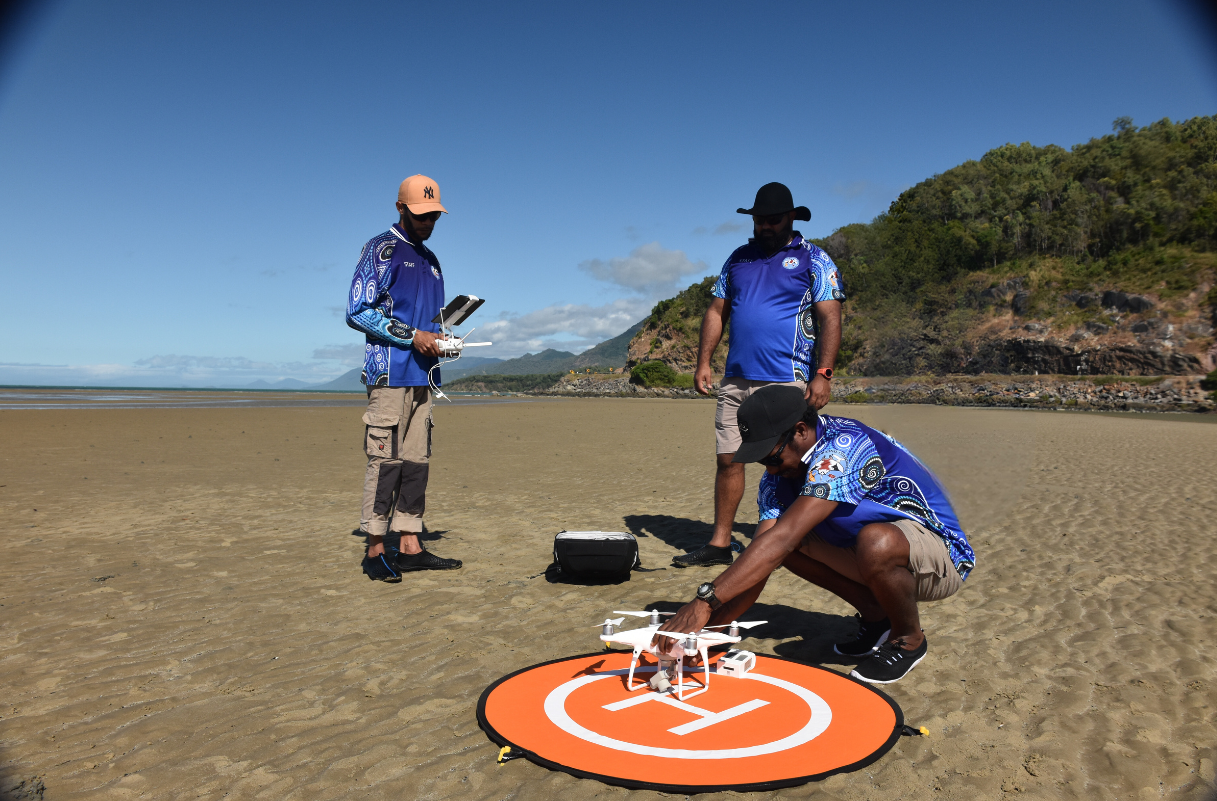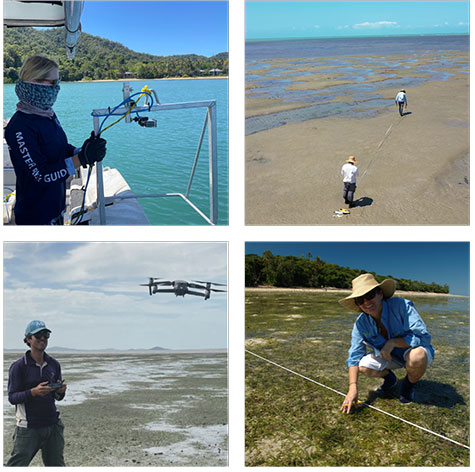Getting Started
register
register with Seagrass-Watch to become a recognised participant of the the program. Registration is free
train
3 endorsed training courses (Intro, level 1, level 2 ) for experienced and confident participants
monitor
trained & competent with Seagrass-Watch protocol, it’s time to start your first monitoring
global seagrass observing network
If you are interested in becoming part of Seagrass-Watch: Global Seagrass Observing Network, please follow the steps outlined below
All data QAQC, interpretation and reporting is conducted by Seagrass-Watch HQ. A qualitative rating system has been developed to assess the status of each locality and region. The rating system is based on scores in a number of categories.
Partner with a local scientist/environment practitioner and identify suitable seagrass site for monitoring.
Receive training from
Register with Seagrass-Watch HQ and become are part of the Global Seagrass Observing Network.
Steps to take
Register with Seagrass-Watch HQ and ensure you are part of the Global network. Become a participant and receive regular updates.
Once we receive your registration form, we will contact you. In the mean time, we ask you to read the training manual. Please make a note of any questions regarding the survey methodology, equipment, data recording and submission or data analysis. When we contact you, we will be able to answer your questions.
Seagrass-Watch HQ provides training where possible to build the capacity of participants to collect information useful for the ongoing management and protection of important marine resources.
Training is for participants 18 years and over and comprises of three components – formal lectures, field training exercise, and laboratory exercise. For more information see Training
As part of Seagrass-Watch QAQC (Quality Assurance/Quality Control), at least 1 participant at each monitoring event must have passed a Seagrass-Watch training course or have a degree (or similar) in environmental/marine science and is able to demonstrate competency in Seagrass-Watch methods & protocols.
Once confident with the Seagrass-Watch protocols, and a suitable site has been identified, it’s time to start your first monitoring. The datasheets can be found in the RESOURCES section of the website. Please choose the correct sheets for your seagrass habitat.
There are Field Guides with percentage cover standards, seagrass identification sheets and examples of “how to” fill out the data sheets. We suggest you print a copy of each field guide, laminate it, and take it into the field with you.
NOTE: As site codes are unique, it is important to request a site code from Seagrass-Watch HQ before establishing a new site. This will ensure your data can be integrated into the program and to prevent confusion in future.
1. Necessary equipment and materials:
- Please make sure you have all the equipment required to contact your monitoring competently and safely.
- 3x 50 metre measuring tapes
- 6x 50cm plastic tent pegs
- compass
- 1x standard (50cm x 50cm) quadrat
- Magnifying glass
- 3x monitoring datasheets
- Clipboard, pencils & 30 cm ruler
- Digital camera
- Quadrat photo labeller
- Percent cover standard sheet
- Seagrass identification sheets
- Global Positioning System (GPS)
2. Make a Timetable
- Create a timetable of times of departure and arrival back, and what the objective of the day is and what is to be achieved on the day. Give a copy of this to all participants involved in advance so they can make their arrangements to get to the site on time.
- Make a list of what the participants need to bring for the field
- hat, sunscreen
- dive booties or old shoes that can get wet
- dress sun smart -wear long pants. But keep clothes light and breathable
- drink/refreshments
- wet weather gear: raincoat
- polaroid sunglasses (not essential)
3. Tide Heights:
Check your tide heights before monitoring, to ensure you site will be exposed and accessible.
- Australia and Pacific: To help plan your Seagrass-Watch monitoring in Australia and the Pacific Islands, be sure to check the tides at the following website: http://www.bom.gov.au/oceanography/tides/
- International: To help plan your Seagrass-Watch monitoring for all other locations, you can download the free shareware program WXTide32 (Version 4.6 2006/06/30). The tide prediction algorithm used in this program was developed with United States Government funding, so no proprietary rights are attached to it. If you would like a copy of the program, visit website: http://www.wxtide32.com/ and follow the links.
Once you have established dates and suitable tide heights for monitoring, submit these in the format below to Seagrass-Watch HQ for publication on the web sampling page.
Site Code :(Day/Month/Date): Tide Time/Tide height see example below:
eg: YP2: Sat Jan 20th: Low tide at 1617 1.0m
4. Permits
- On-ground monitoring in some locations may require permits (e.g., Marine Parks). For a permit to be issued, there is often a fee required. You will need to check with local authorities (Parks and Wildlife) and Seagrass-Watch HQ before conducting any monitoring program in marine waters.
Marine Plants are protected in Queensland, Australia.
5. Safety
Please read the following safety section before you begin any fieldwork.
- Have a Contact Person:Arrange to have a reliable contact person to raise the alert if you and the team are not back at a specified or reasonable time.
- Assess the risks before monitoring – check weather, tides, time of day, etc.
- Use your instincts – if you do not feel safe then abandon sampling.
- Do not put yourself or others at risk.
- Wear appropriate clothing and footwear.
- Be sun-smart.
- Be aware of dangerous marine animals.
- Have a first aid kit on site or nearby
- Take a mobile phone or marine radio
To download the Seagrass-Watch risk assessment form Click Here.
For more detailed information please contact Seagrass-Watch HQ
Seagrass-Watch has several monitoring strategies depending on the type and location of seagrass meadows.
If you do not think the method is suitable for your seagrass meadows (for example, the seagrass meadow is subtidal or not of a size able to contain a 50m by 50m site), contact Seagrass-Watch HQ for advice.
Check data sheets are filled in fully.
- Ensure the full names of all observers (last name and first name), the date and site/quadrat details are clearly recorded on the datasheet. Also record the number of other observers assisting.
- Also record the GPS positions of the end of each transect.
Remove equipment from site
- Remove all non-permanent pegs and roll up the tape measures. If the tape measures are covered in sand or mud, roll them back up in water.
Wash & pack gear
- Rinse all tapes, pegs and quadrats with freshwater and let them dry.
- Review supplies for next quarterly sampling and request new materials
- Store gear for next quarterly sampling
Press any voucher seagrass specimens if collected
- For more detail on voucher specimens: Click Here
After you finish your Seagrass-Watch survey, please submit the data via email to admin@seagrasswatch.org (See Data entry section -Click here).
Mail all original datasheets, photos and herbarium sheets to:
Seagrass-Watch HQ
PO Box 4
Clifton Beach
QLD 4879
AUSTRALIA
For data submission checklist: Click Here
All data interpretation and reporting is conducted by Seagrass-Watch HQ. A qualitative rating system has been developed to assess the status of each locality and region. The rating system is based on scores in a number of categories.
Seagrass global observing network
If you are interested in becoming part of Seagrass-Watch: Global Seagrass Observing Network, please follow the steps outlined below
Steps to take
Register with Seagrass-Watch HQ and ensure you are part of the Global network. Become a participant and receive regular updates.
Once we receive your registration form, we will contact you. In the mean time, we ask you to read the training manual. Please make a note of any questions regarding the survey methodology, equipment, data recording and submission or data analysis. When we contact you, we will be able to answer your questions.
Seagrass-Watch HQ provides training where possible to build the capacity of participants to collect information useful for the ongoing management and protection of important marine resources.
Training is for participants 18 years and over and comprises of three components – formal lectures, field training exercise, and laboratory exercise. For more information see Training
As part of Seagrass-Watch QAQC (Quality Assurance/Quality Control), at least 1 participant at each monitoring event must have passed a Seagrass-Watch training course or have a degree (or similar) in environmental/marine science and is able to demonstrate competency in Seagrass-Watch methods & protocols.
Once confident with the Seagrass-Watch protocols, and a suitable site has been identified, it’s time to start your first monitoring. The datasheets can be found in the RESOURCES section of the website. Please choose the correct sheets for your seagrass habitat.
There are Field Guides with percentage cover standards, seagrass identification sheets and examples of “how to” fill out the data sheets. We suggest you print a copy of each field guide, laminate it, and take it into the field with you.
NOTE: As site codes are unique, it is important to request a site code from Seagrass-Watch HQ before establishing a new site. This will ensure your data can be integrated into the program and to prevent confusion in future.
1. Necessary equipment and materials:
- Please make sure you have all the equipment required to contact your monitoring competently and safely.
- 3x 50 metre measuring tapes
- 6x 50cm plastic tent pegs
- compass
- 1x standard (50cm x 50cm) quadrat
- Magnifying glass
- 3x monitoring datasheets
- Clipboard, pencils & 30 cm ruler
- Digital camera
- Quadrat photo labeller
- Percent cover standard sheet
- Seagrass identification sheets
- Global Positioning System (GPS)
2. Make a Timetable
- Create a timetable of times of departure and arrival back, and what the objective of the day is and what is to be achieved on the day. Give a copy of this to all participants involved in advance so they can make their arrangements to get to the site on time.
- Make a list of what the participants need to bring for the field
- hat, sunscreen
- dive booties or old shoes that can get wet
- dress sun smart -wear long pants. But keep clothes light and breathable
- drink/refreshments
- wet weather gear: raincoat
- polaroid sunglasses (not essential)
3. Tide Heights:
Check your tide heights before monitoring, to ensure you site will be exposed and accessible.
- Australia and Pacific: To help plan your Seagrass-Watch monitoring in Australia and the Pacific Islands, be sure to check the tides at the following website: http://www.bom.gov.au/oceanography/tides/
- International: To help plan your Seagrass-Watch monitoring for all other locations, you can download the free shareware program WXTide32 (Version 4.6 2006/06/30). The tide prediction algorithm used in this program was developed with United States Government funding, so no proprietary rights are attached to it. If you would like a copy of the program, visit website: http://www.wxtide32.com/ and follow the links.
Once you have established dates and suitable tide heights for monitoring, submit these in the format below to Seagrass-Watch HQ for publication on the web sampling page.
Site Code :(Day/Month/Date): Tide Time/Tide height see example below:
eg: YP2: Sat Jan 20th: Low tide at 1617 1.0m
4. Permits
- On-ground monitoring in some locations may require permits (e.g., Marine Parks). For a permit to be issued, there is often a fee required. You will need to check with local authorities (Parks and Wildlife) and Seagrass-Watch HQ before conducting any monitoring program in marine waters.
Marine Plants are protected in Queensland, Australia.
5. Safety
Please read the following safety section before you begin any fieldwork.
- Have a Contact Person:Arrange to have a reliable contact person to raise the alert if you and the team are not back at a specified or reasonable time.
- Assess the risks before monitoring – check weather, tides, time of day, etc.
- Use your instincts – if you do not feel safe then abandon sampling.
- Do not put yourself or others at risk.
- Wear appropriate clothing and footwear.
- Be sun-smart.
- Be aware of dangerous marine animals.
- Have a first aid kit on site or nearby
- Take a mobile phone or marine radio
To download the Seagrass-Watch risk assessment form Click Here.
For more detailed information please contact Seagrass-Watch HQ
Seagrass-Watch has several monitoring strategies depending on the type and location of seagrass meadows.
If you do not think the method is suitable for your seagrass meadows (for example, the seagrass meadow is subtidal or not of a size able to contain a 50m by 50m site), contact Seagrass-Watch HQ for advice.
Check data sheets are filled in fully.
- Ensure the full names of all observers (last name and first name), the date and site/quadrat details are clearly recorded on the datasheet. Also record the number of other observers assisting.
- Also record the GPS positions of the end of each transect.
Remove equipment from site
- Remove all non-permanent pegs and roll up the tape measures. If the tape measures are covered in sand or mud, roll them back up in water.
Wash & pack gear
- Rinse all tapes, pegs and quadrats with freshwater and let them dry.
- Review supplies for next quarterly sampling and request new materials
- Store gear for next quarterly sampling
Press any voucher seagrass specimens if collected
- For more detail on voucher specimens: Click Here
After you finish your Seagrass-Watch survey, please submit the data via email to admin@seagrasswatch.org (See Data entry section -Click here).
Mail all original datasheets, photos and herbarium sheets to:
Seagrass-Watch HQ
PO Box 4
Clifton Beach
QLD 4879
AUSTRALIA
For data submission checklist: Click Here
All data interpretation and reporting is conducted by Seagrass-Watch HQ. A qualitative rating system has been developed to assess the status of each locality and region. The rating system is based on scores in a number of categories.
